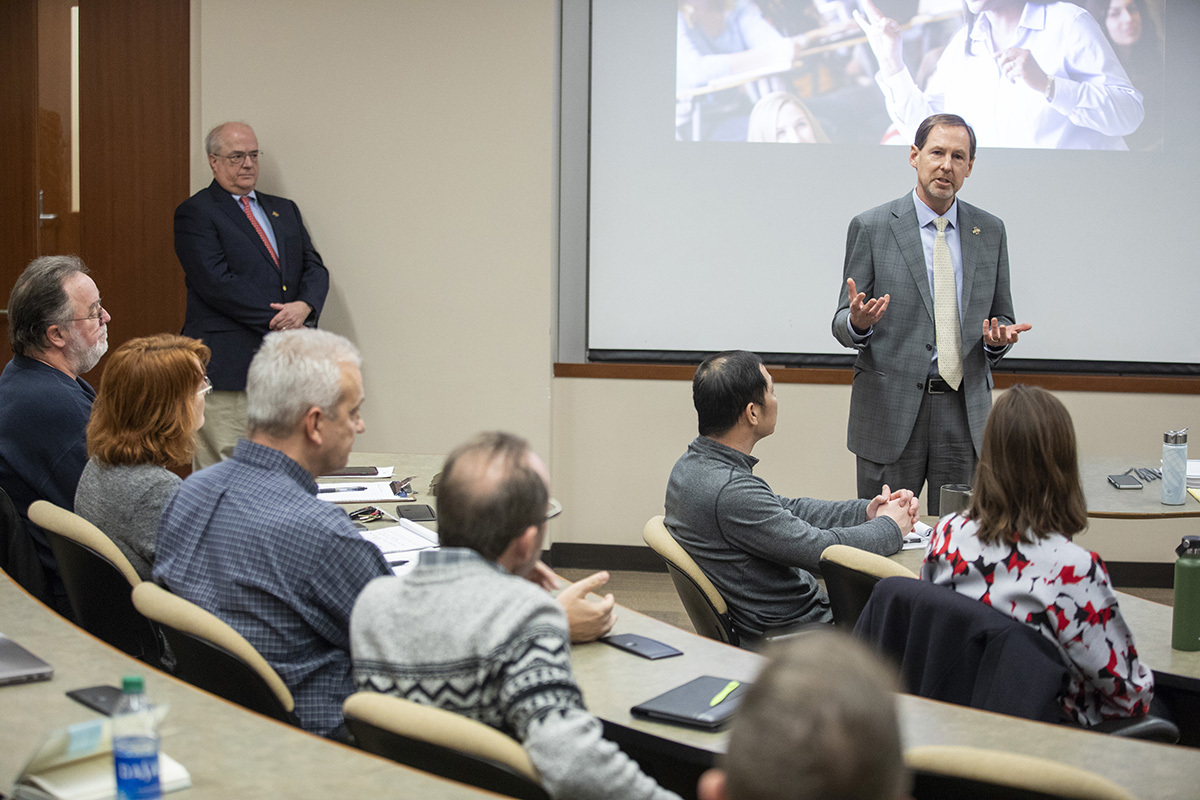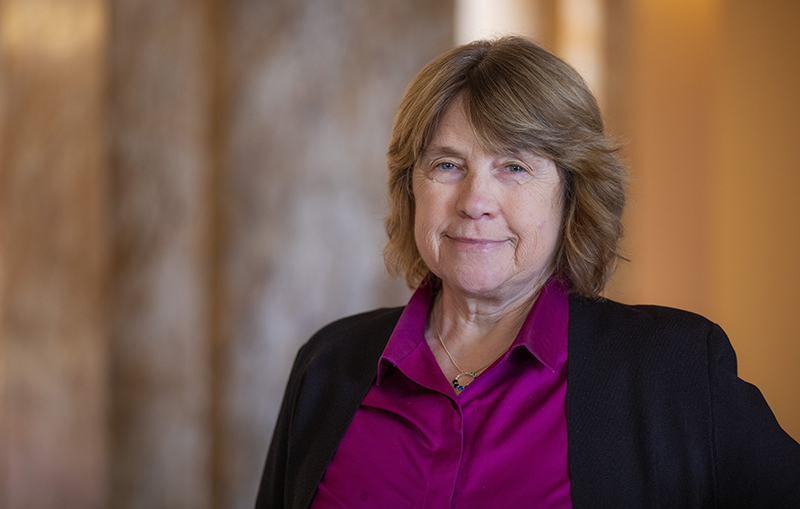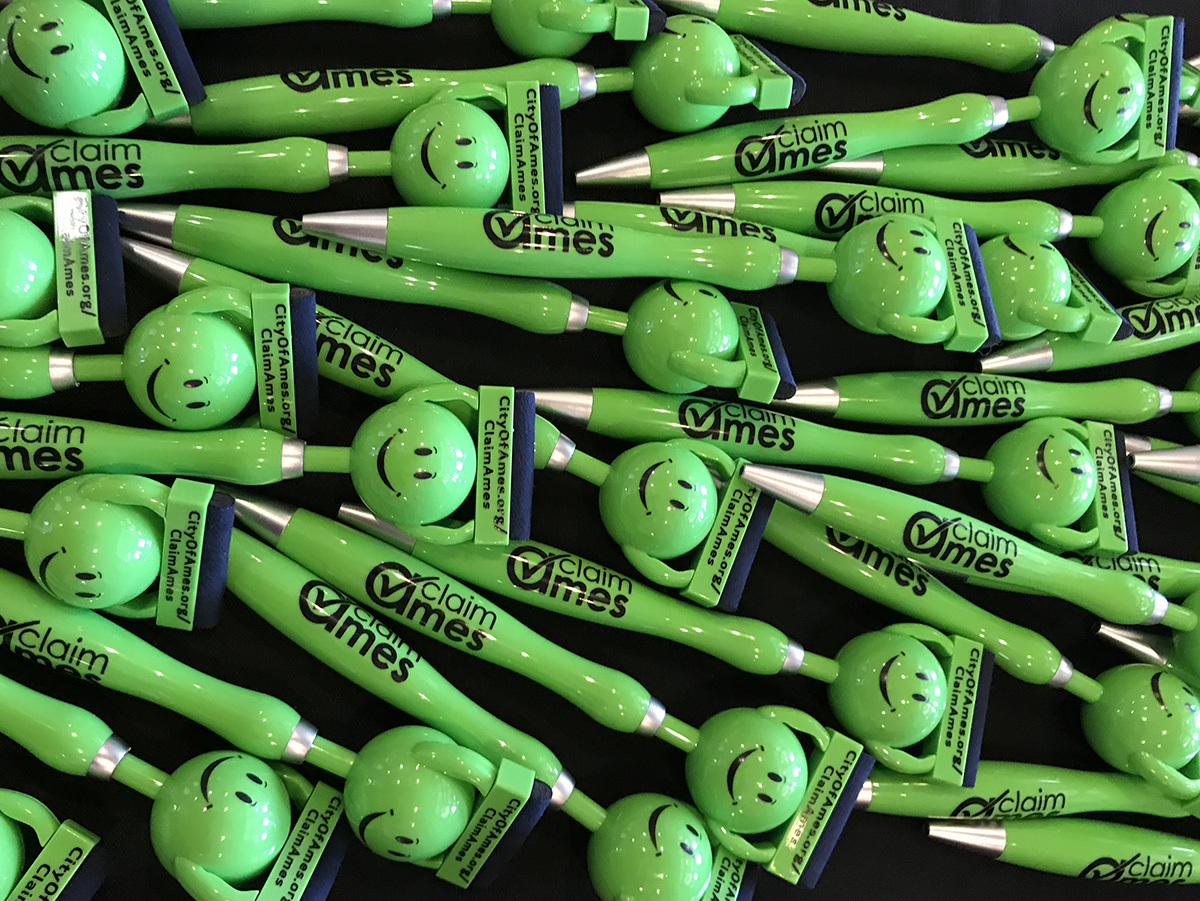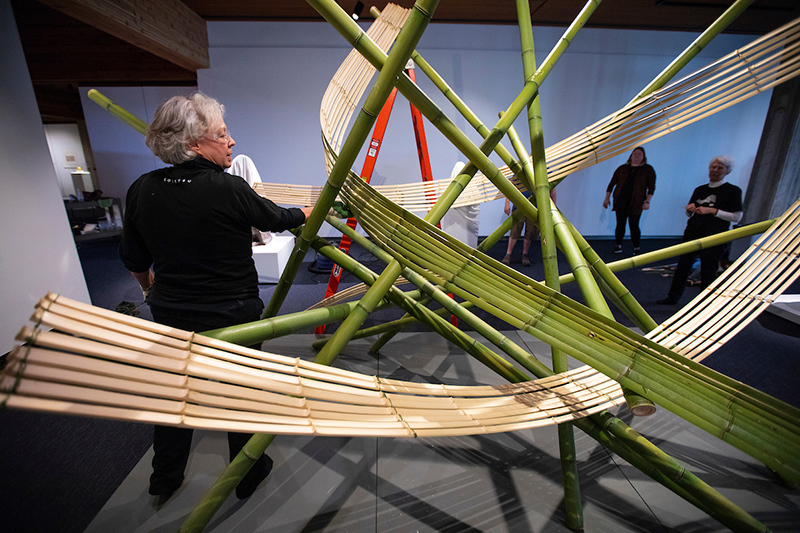A fresh start

Photo by Christopher Gannon.
It's been a mild, green winter to date, but a layer of new snow greeted students and employees Monday on the first day of the semester. Pictured, students pass by Curtiss Hall on their way to class.
Annual inclusive classroom training for faculty is underway

Senior vice president and provost Jonathan Wickert (right), speaks to Ivy College of Business faculty at the outset of the inclusive classroom workshop delivered by CELT staff on Jan. 10. David Spalding, Raisbeck Endowed Dean of the Debbie and Jerry Ivy College of Business (left), also listens. Photo by Christopher Gannon.
With a new semester underway, faculty leading classes will find themselves in the same seats as their students as part of training to enhance their ability to create inclusive classrooms.
President Wendy Wintersteen outlined 10 actions in November to addresses racism and discrimination on campus in response to concerns from Students Against Racism. Among them is annual training for faculty focused on inclusive teaching in class. The Center for Excellence in Learning and Teaching (CELT) uses its inclusive classroom workshop as the basis to conduct training, which began last week.
"The purpose of a land-grant institution is to educate our students, and part of education is feeling like you belong," CELT director Sara Marcketti said. "You really can't learn something if you feel like you are on the outskirts and you don't matter. We all have a responsibility to help one another."
Senior vice president and provost Jonathan Wickert told the inaugural group, the Ivy College of Business' management department, the training is designed to help instructors better understand students.
"Fifty years ago, we had 277 multicultural students on campus," Wickert said. "Today, international students make up a quarter of our campus.
"Times are different. Look at the demographic shifts and changes happening in the Midwest. That shift is going to continue and our campus will continue to become more diverse. One of the things we do at universities is learn and improve, and that is really what the inclusive classroom program is about."
The workshop
All 56 academic departments must complete the training by June.
"Our initial inclusive classroom training was three hours long, but we want this to be a good baseline focused on an active learning approach," Marcketti said. "Departments can decide if they want one, two or three hours."
Marcketti, CELT program coordinator Laura Bestler, four CELT faculty fellows and a training specialist not yet hired will conduct this year's training.
The goal of the workshop is for participants to understand why teaching inclusively is important and to identify course-specific improvements that can be made to encourage inclusiveness.
The workshop begins with a 15-minute presentation. Then for the remainder of the time together, participants reflect on their teaching methods and they discuss three areas of inclusive teaching:
- Course design
- Teaching strategies
- Evaluation practices
Participants are given time to think about each area before sharing ideas with a partner and discussing ideas with the group. The large group element allows participants to bring examples of situations they have faced in the classroom and to learn from each other.
"It is very constructive. It is about things you can do, and it is about how you structure classes," said Brad Shrader, University and Morrill Professor of management. "They covered a lot in a short amount of time."
Although the training is yearly, the information will rotate on a four-year cycle of topics:
- Inclusive classroom workshop
- Build an inclusive and learner-centered syllabus
- Explore ways to create an inclusive learning environment
- Facilitate dialogue in the classroom
Pre-homework for participants
The training uses a flipped classroom approach that starts before participants attend a workshop. Everyone must complete three online modules available in Canvas that take about an hour to finish:
- Why teach inclusively?
- How implicit bias impacts your teaching
- Key components of teaching inclusively
Faculty are able to confidentially provide feedback after completing the modules. Many have found them helpful and informative through comments they have shared, Marcketti said.
"I wasn't aware of the goals of a land-grant institution," a participant said. "I now recognize our duty to help those who might not have experienced diversity before to see the value in what everyone can contribute and truly appreciate diversity."
Participation
Attendance at a workshop is mandatory and tracked by department chairs. Faculty or staff unable to attend a workshop with the rest of the department can join another department in their college. College deans will send annual participation reports to Wickert.
Each department is led by a faculty facilitator who works with CELT to arrange training, including finding a space large enough to accommodate the group.
Currently, 47 departments have scheduled training. Facilitators also are encouraged to join a monthly learning community that will be formed and open to everyone on campus.
Is it working?
To ensure training remains effective, CELT will create an inclusive classroom advisory committee.
Each workshop participant also is asked to fill out an evaluation form on the training to make sure the most pertinent information is taught.
Related stories
- Small changes can have big impact for inclusive classrooms, Feb. 21, 2019
New W-4 form brings changes for federal withholding choices
W-2 availability
Payroll staff are working on W-2 and 1095 documents, running tests and audits to make sure results are accurate following the midyear transition to Workday. W-2s should be available next week.
New hires and current employees making changes to their federal income tax withholding elections have encountered an unfamiliar sight since Jan. 1, as the Internal Revenue Service overhauled its longstanding W-4 form. The new document is more detailed.
Under the old system for determining how much is deducted from a paycheck for federal income tax, employees declared their marital status and a certain number of allowances. More allowances meant less withheld, as did indicating "married" status. That information aligned with a withholding table matrix that dictated how much was withheld. Withholding is used to pay federal income taxes due each year in April. If too much is withheld, a taxpayer gets a refund. If too little is withheld, they must pay the IRS the difference.
As of Jan. 1, employees still list their tax-filing marital status, but the revamped method scraps allowances. The more specific form asks about dependents that may qualify for the child tax credit, other household income and expected itemized deductions.
"It's almost a mini-exercise in doing your actual tax return," said Tim Ashley, interim assistant vice president for payroll, benefits and tax.
The change by the IRS, which applies to all U.S. payroll, was prompted by surprises in the wake of the federal tax cuts and job act that took effect in 2018. New regulations, deductions and credits brought unexpected bills or refunds for some taxpayers.
The modified W-4 aims to level out those swings, matching withholding more closely with how much tax an employee will owe. The more information provided, the more accurate the deductions should be. Providing details is optional, though. Marital status for tax-filing purposes is the only information employees are required to offer, Ashley said.
The new W-4 doesn't impact current employees who want to keep their withholding as it is. Their federal deduction rate will hold steady if they take no action, and no changes are required. But if employees want to alter their withholding, they'll use the new form and should be sure to monitor the effects, Ashley said.
"I'd highly recommend that they watch their paycheck closely to make sure they're ending up with the result they intended," he said.
Changes to W-4 withholding elections are made in Workday. Click on the "Pay" icon on the home screen and then "Withholding Elections" to update state and federal choices. The new federal form doesn't impact Iowa's version of the W-4, which still is based on allowances and marital status.
In the coming weeks, the payroll office will publish a job aid that helps explain the W-4 and provides tips, Ashley said. Payroll staff also are available for individual questions or departmental presentations about the new W-4. Questions and presentation requests can be submitted to payroll@iastate.edu.
Welcome

Director of academic quality and undergraduate education Shawn Boyne began in the position Jan. 8. Photo by Christopher Gannon.
Shawn Boyne began in the provost's office on Jan. 8, taking over the role of director of academic quality and undergraduate education. She will lead and coordinate academic program effectiveness, including program review and accreditation, undergraduate student success initiatives and outcomes assessment.
She comes from Indiana University, Bloomington, where she was a law professor and created a successful diversity pipeline program for the law school. During the 2018-19 academic year, she served as an American Council on Education fellow at James Madison University, Harrisonburg, Virginia.
In addition to earning a law degree at the University of Southern California, Los Angeles, Boyne has a bachelor's degree in government from Cornell University, Ithaca, New York; a master of business administration degree from the University of Minnesota, Minneapolis; and a doctoral degree in political science from the University of Wisconsin, Madison. Prior to her academic career, she was a child abuse and sex crimes prosecutor in New Mexico and a contract public defender.
Boyne's office is in 1550 Beardshear Hall. She can be reached by phone at 294-7063 and by email at smboyne@iastate.edu.
Students, faculty are invited to use online grammar tool
Iowa State began a one-year pilot of an online grammar assistance tool this month. All students and faculty can create an account for Grammarly's premium edition via their MyCanvas website or directly at grammarly.com/enterprise/signup. The initiative is supported with $57,000 in student technology fees approved last spring by the Computation Advisory Committee, since renamed CASTLE.
Grammarly is a cloud-based service that uses natural language processing and machine learning to find and correct spelling, punctuation and grammar errors. The premium version includes plagiarism detection and suggests improvements for style, tone and vocabulary choices. It works across multiple platforms including web browsers, Google Docs and Microsoft Word and Outlook (PC only). It also works on mobile phones and tablets.
While any ISU student can use Grammarly premium on their own, assistant professor of English Jim Ranalli views course integration as the best way to motivate students to try the tool and incorporate it into their writing process. As part of the team promoting the Grammarly rollout this winter, Ranalli will be trying to persuade faculty and staff instructors to weave it into assignments this semester. Faculty who want Grammarly premium invitations sent to the students in their classes may contact Ranalli, jranalli@iastate.edu.
Ranalli led an early classroom pilot of Grammarly last year with Miller grant support. The 26 participating faculty from eight departments generally concluded that Grammarly made it easier to read and evaluate students' written work, allowing instructors to focus on higher-level writing issues such as organization, content and demonstration of learning.
"We find Grammarly facilitates an efficient division of labor when it comes to providing feedback on writing," Ranalli said.
ISU updates on Grammarly
Twitter: @ISUGrammarly
Facebook: Grammarly at Iowa State
Instagram: isugrammar
Activate your account
A Grammarly page for faculty has been set up in MyCanvas: Teacher at ISU, under "Modules" and then "External Apps." The page provides information about establishing an account and using Grammarly. Once on Grammarly's signup, faculty will provide name, ISU email address and a password (Okta integration is coming later) to activate their own account. All Iowa Staters must use their ISU email address -- not a personal one -- to successfully open an account. This is how Grammarly knows to admit them.
Students will find similar information in their MyCanvas: Student page under "Modules" and "Other Tools Available to Students."
Due to the funding source (student fees), non-instructional staff can't be included in the university contract.
Does it work?
Ranalli and others will be busy over the next year assessing who's using Grammarly and how they use it. One of the planned studies is a collaboration with the student affairs division's Writing and Media Center to identify best practices for introducing Grammarly to students who seek help at the center. Most students who go there are seeking grammar help, he said.
"There's a real opportunity to introduce Grammarly as way of addressing grammar concerns and making students aware of the value of the Writing and Media Center for higher-level things they also need to be thinking about," he said.
Ranalli also will look into Grammarly's effectiveness in detecting errors in different kinds of writing, for example a freshman essay versus a researcher's grant proposal.
If students and faculty use Grammarly and find value in it, Ranalli said the subscription could be renewed. CASTLE has committed to funding a second year if it's meeting expectations.
P&S Council recommends pay raises exceeding inflation
The Professional and Scientific Council is recommending a salary increase next year that at least outstrips inflation.
At its meeting Jan. 9, the council approved its recommendation and accompanying report on compensation and benefits, a nonbinding proposal it annually produces for administrators to consider as they set next year's budget.
The recommendations call for fiscal year 2021 salary increases of at least 0.5% above inflation for P&S staff who are meeting performance expectations and 1.5-2% increases above inflation for those exceeding expectations. Annual inflation has been around 2% for the past three years, based on the federal Consumer Price Index, making the council's recommendation roughly 2.5-4%.
Iowa State should make salary increases "a priority in budget preparations with the same effort in which new construction and initiatives around campus are championed," the council's recommendation states.
The FY21 proposal also calls for offering more professional development training, find new revenue sources, improving annual performance reviews as suggested last year, maintaining employee benefits and implementing the results of the P&S classification and compensation review.
This year's version of the report tried to use more forceful language, following three years of minimum raises that fell below annual inflation.
"You will note the tone of the document is a bit more aggressive than in years past. That was done deliberately. I don't know if it will work, but it's worth a try," said Barry McCroskey, the council's vice president for university planning and budget.
Student and international residents should 'Claim Ames' on 2020 census

Promotional giveaways will be used as part of the "Claim Ames" awareness campaign for the 2020 U.S. Census.
Postcards with instructions for completing the 2020 United States census will be mailed in March, and the city is urging students to "Claim Ames." President Wendy Wintersteen joined city leaders for a Jan. 13 kickoff event.
"The census rules are clear -- Iowa State University students living in Ames should claim Ames on the census form," Wintersteen said. "We know that a complete and accurate census count benefits both the city of Ames and Iowa State University so we can access critical federal funds."
A constitutional mandate, the U.S. census is a population snapshot taken every 10 years. New in 2020, responses can be submitted in multiple languages both online and by phone. Address-specific census ID numbers will be included on the postcards that arrive in mailboxes over spring break. Paper forms, available in English and Spanish, will be available by request.
Who fills it out?
Anyone living here on April 1 should claim Ames, including Iowa State and international (noncitizen) students. ISU staff will coordinate the process for students in group living situations, such as department of residence and Greek housing. From May through July, census takers will visit addresses that haven't responded.
Why do it?
Federal funding and political representation are determined by census data. Business decisions such as retail expansion also are informed by population numbers.
"It's important to Iowa State University for everything from transportation funding for CyRide to public safety. It also helps bring in new businesses to town -- like new coffee shops, restaurants, the pharmacy in Campustown and other popular spots for students," Wintersteen said.
How long will it take?
The census form should only take a few minutes to complete, with about a dozen basic questions for the typical household.
Is it safe?
By law, responses are confidential. The Census Bureau does not share personal or identifiable information with other government offices or law enforcement agencies.
Now hiring
John Cook, a senior partnership specialist from the U.S. Census Bureau, encouraged local community members to apply for the temporary paid positions needed to help the effort. Schedules are flexible with an hourly base pay rate of $21.50.
"We are looking for field enumerators and other workers to help us make sure everyone in Story County and everyone in Ames is counted," Cook said.
Bamboo arrangement complements Brunnier exhibition

Alumna Marcia Borel, left, makes an adjustment to "Undulation," a bamboo arrangement in the sogestsu ikebana style that welcomes visitors to university museums' "Contemplate Japan" exhibition in the Brunnier Art Museum. Photo by Christopher Gannon.
Attired in matching T-shirts, four women who study Japanese floral art together in western Philadelphia worked for two days this week to design a sogestu ikebana arrangement in the Brunnier Art Museum's front gallery. Created from bamboo and wire, it measures approximately 12 feet by 8 feet by 12 feet, a striking piece in university museums' "Contemplate Japan" exhibition running through the end of July. It opened Wednesday.
Sogetsu, a style within the broad ikebana craft, is a modern (1927), less rigid variety of arranging plant materials.
The team was led by Marcia Borel of Chadds Ford, Pennsylvania, a 1978 ISU alumna. Joining her were Marlys Kerr and Margaret Odiorne of Wilmington, Delaware, and Debra Dickinson, Malvern, Pennsylvania. Borel and her husband, Jim, also from the class of 1978, commissioned a 2015 Rose Frantzen painting of George Washington Carver and a young Henry Wallace, "Do You Know What's Inside This Flower?" for university museums. Through that project, they met museums director Lynette Pohlman.
The "Contemplate Japan" exhibition will include more than a dozen education programs. Featured ceramics artist Peter Hamann, who studied in Iowa but lives and works in Japan, opens the series Sunday afternoon, Jan. 19, with an artist talk at 2 p.m. Three of the sogetsu specialists will return in mid-April and, with other sogetsu designers from the Kansas City area, create more arrangements that will be part of the exhibition for about a week.
Orchestra director brings diversity concert to campus
Director of orchestral activities Jonathan Govias, who joined the ISU faculty last summer, brought his "Symphony of Diversity" concept with him and is preparing for two Stephens Auditorium concerts in early March.
The annual concert, which he started in spring 2017 at the University of North Carolina, Charlotte, will feature the ISU Symphony Orchestra, one or two guest artists and music by underrepresented composers -- this year, African American, Mexican and female composers.
Symphony of Diversity concerts
Thursday, March 5, 7:30 p.m.
Friday, March 6, 10 a.m.
Confirmed for this spring's concert is Adrian Anantawan, a Canadian violinist of Chinese and Thai descent born without a right hand. In addition to performing professionally throughout Canada and the United States, Anantawan serves as music department chair at the K-12 Milton Academy in suburban Boston.
Govias said the concerts are "an effort to model positive racial and ethnic inclusion through a traditionally white art form."
The Symphony of Diversity, he said, "celebrates, without confronting; advocates through example, not speech; and creates a bridge to a broader public that is both welcoming and inspiring."
Govias invites faculty and staff to:
- Attend one of the free concerts.
- Submit proposals/requests now for how the guest artist(s) might interact with and impact a campus audience, including classes and student organizations.
- If you play an orchestral instrument other than piano, join the symphony for the first and last pieces in the approximately 70-minute concert (one or both dates, as your schedule allows). Weekly rehearsals begin Jan. 21 (Tuesdays 4:10-5 p.m., Music Hall).
To act on item 2 or 3, email Govias at jgovias@iastate.edu.
